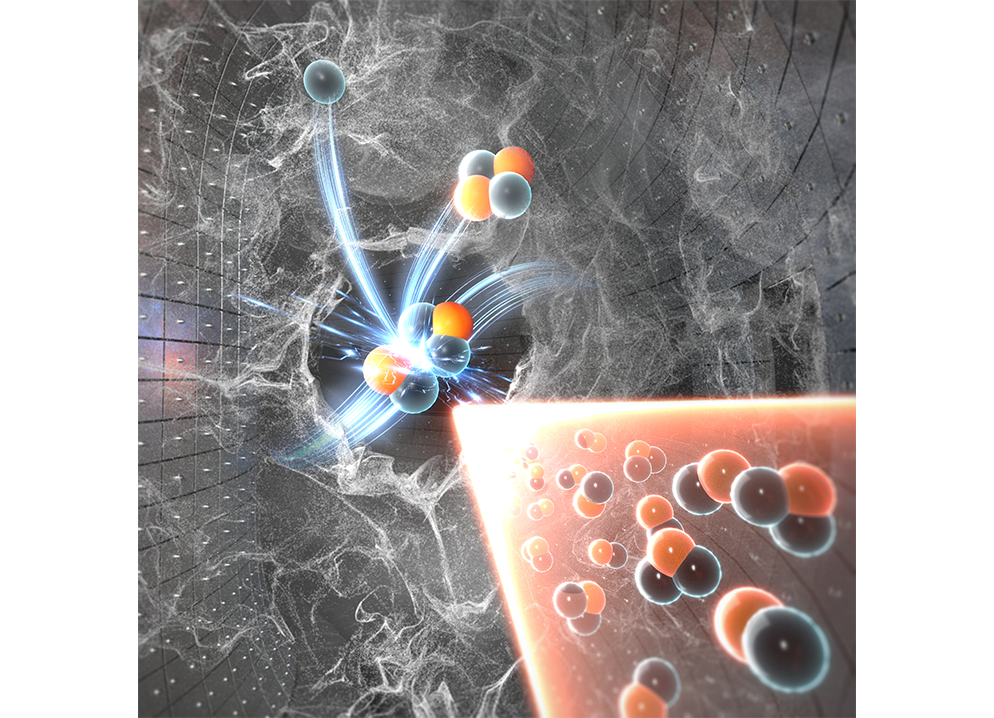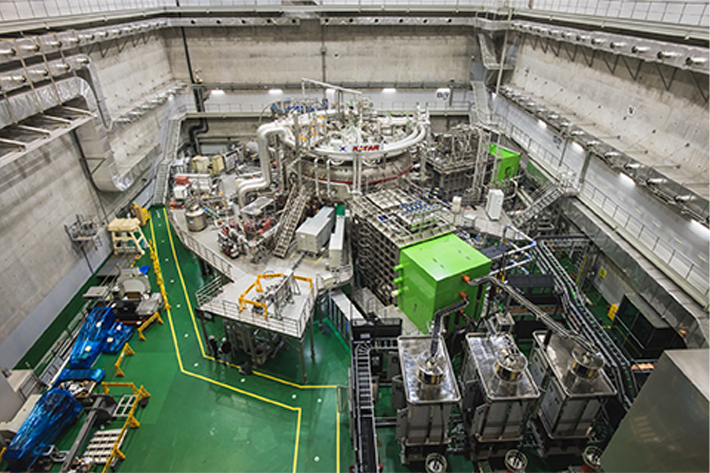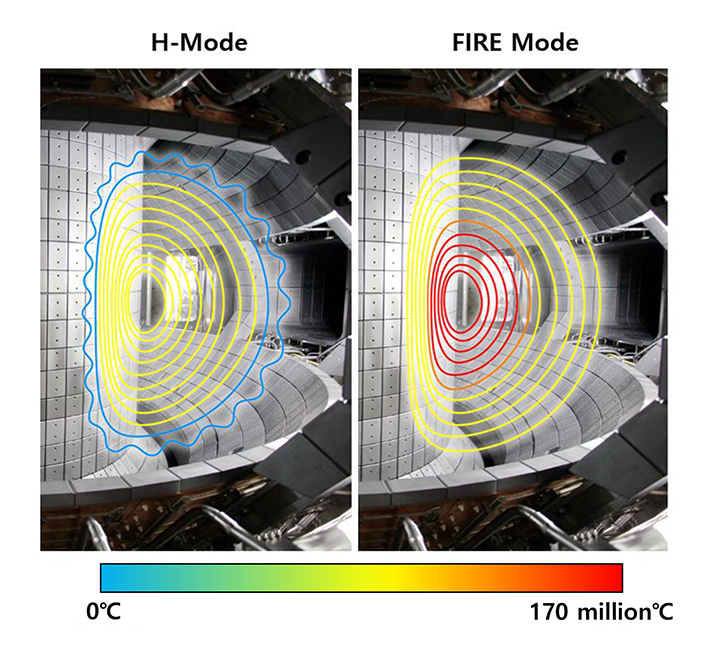
‘FIRE mode’ expected to resolve operational difficulties of commercial fusion reactors in the future
Published in <Nature> on September 8th, 2022
Researchers from Seoul National University (SNU) and the Korea Institute of Fusion Energy (KFE) have developed a new operating mode to sustain nuclear fusion plasmas with an ultra-high temperature of over 100 million degrees Celsius for a long period of time in the Korea Superconducting Tokamak Advanced Research (KSTAR).

Figure 1
Photo of KSTAR, a tokamak device that confines
plasmas with superconducting magnet coils
To generate net energy through a fusion reaction as occurs in the sun, the highly ionized state of matter, so-called plasma, must be confined at a high temperature above 100 million Celsius degrees stably for a long time. While various technical challenges still exist, the researchers set a record that a fusion plasma has lasted for 30 seconds at temperatures beyond 100 million Celsius degrees through the KSTAR.
There are some sets of methods to stably operate fusion plasmas called operating modes. One of the most widely known operating modes is high-confinement mode (H-mode). H-mode is to suppress plasma turbulence at the edge region for high confinement of fusion plasmas. The mode has been considered the primary operating mode for a fusion reactor such as the International Thermonuclear Experimental Reactor (ITER). ITER is the world’s largest tokamak, being built in France through a collaboration between China, the European Union, India, Japan, the Republic of Korea, Russia and the U.S.A. However, H-mode also holds limitations. The high confinement of plasma at the edge region causes instabilities called edge-localized modes (ELMs), which damage the inner walls of a reactor. ELMs should be avoided at a large size device such as ITER.
Researchers have been developing various ways to control ELMs or developing an alternative operating mode to avoid ELMs. An alternative operating mode without ELMs, internal transport barrier mode (ITB-mode), obtains high confinement of fusion plasmas by suppressing plasma turbulence at the core region. Nevertheless, researchers find it difficult to operate ITB-mode stably for a long time due to severe instabilities and impurity accumulation in the core region.
The new operating mode, which endured high-temperature fusion plasma above 100 million Celsius degrees for 30 seconds, functions like the ITB-mode but without severe instabilities nor impurity accumulation in the core region. By analyzing experimental data of KSTAR operations through simulations, SNU and KFE researchers found that the fast or high-energy ions, generated due to external heating, stabilize the turbulences inside the plasma. The main causes of confinement degradation resulted in a dramatic increase of the plasma temperature.
This high-temperature plasma could be stably sustained for a prolonged period of time by keeping a large amount of the fast ions resulting from external heating. Researchers coined the term fast-ion-regulated enhancement (FIRE) mode for this new mode. The FIRE mode holds various advantages: unlike H-mode, ELMs do not occur, and the FIRE mode does not require sophisticated control for the operation, owing to its stability.

Figure 2
A simulation image of H-mode, left, and the fast
ion regulated enhancement mode (FIRE mode)
shows that the higher temperature is concentered
in the core of the plasma in FIRE mode.
“FIRE mode came as a work of creativity while analyzing the reasons for failing to achieve the desired results in experiments. A failure guided a new discovery, FIRE mode,” said Prof. Yong-Su Na, the corresponding author of the study." This finding was made possible thanks to the close cooperation between the KFE, SNU, and other universities in and outside of Korea. The discovery was also made possible through KSTAR, which was built to the finest level with a very low magnetic error field to access the operation condition of low plasma density," he added.
One of the first authors, Mr. Sangjin Park also emphasized the strong collaboration among institutions for further progress in developing FIRE mode.
"There are three elements to consider in making fusion reactions; density, temperature, and confinement time. Among those three, we took a new approach and focused on the temperature. We succeeded in developing FIRE mode, specifically by concentrating the KSTAR’s heating capabilities to the core of the plasma at low density,” said Dr. Hyunsun Han, the first author of the paper. “We plan to enhance KSTAR’s plasma performance and operation time at over 100 million degrees Celsius by studying further on the FIRE mode and fast ions,” he explained.
Since FIRE mode can improve the plasma performance while generating no ELM, unlike the H-mode, and providing easier operational control, experts expect the mode to open new possibilities. The mode may aid the development of plasma operation technology for commercial fusion reactors and contribute to the operation of ITER.
* Research title: A sustained high-temperature fusion plasma regime facilitated by fast ions (Corresponding author: Professor Yong-Su Na of Department of Nuclear Engineering at Seoul National University, First Author: Dr. Hyunsun Han of Korea Institute of Fusion Energy, Sangjin Park of Department of Nuclear Engineering at Seoul National University)
NOTE 1 Glossary
1. Fusion Energy : Energy from fusion reaction, which is how the solar energy works in the sun. Research is underway to artificially generate fusion energy on earth for a future energy source.
2. Plasma : The fourth state of free-moving matter in which the nucleus and electrons are separated. It takes up 99.9% of the universe. As the state of plasma at an ultra-high temperature, the nucleus takes over the repulsive force and fuses in the fusion reaction. The key to fusion technology is to sustain the high temperature of plasma for as long as necessary to allow fusion to take place within the fusion device.
3. KSTAR (Korea Superconducting Tokamak Advanced Research) : A superconducting fusion reactor built by the KFE with Korea’s home-grown technology after 12 years of research and construction from 1995 to 2007. It succeeded in plasma generation for the first time in 2008. It is the first device across the globe that was made of the same superconducting material as the International Thermonuclear Experimental Reactor (ITER), which is under development by major developed countries. It is at the center of attention as the core device for the fusion device for joint international fusion research. Plasma experiments take place at the KSTAR every year to develop new and innovative fusion technology.
4. Fast Ions : Among the ions that make up plasma in a fusion reactor, these ions have several times higher kinetic energy than that of others, which is usually caused by external heating or a fusion reaction. Holding these fast ions stably is critical to plasma performance because the kinetic energy of those ions is transferred to others, facilitating the attainment of ultra-high temperatures.
5. Edge Localized Mode (ELM) : Instability caused by fluctuating pressure on the edges of the high temperature tokamak plasma. This was found for the first time in the ASDEX device in Germany in the 1980s. When the ELM occurs, a large amount of energy inside the plasma is released, which in turn reduces the confinement performance of the Tokamak unit, causing significant damage to the inner walls of the device. Since the ELM should be controlled for stable operation of the fusion device, how the ELM works and how to control it are being studied at every major fusion device worldwide.
6. H-mode : A phenomenon where the plasma confinement capability under certain operating conditions is roughly doubled at a Tokamak-type fusion device. This was first known in 1982 as measured by the ASDEX device in Germany. The KSTAR achieved the H-mode in 2010 for the first time among the superconducting fusion devices. Since the H-mode signifies excellent operating performance of fusion devices, the ITER device also plans to have the H-mode as its default operation mode.


